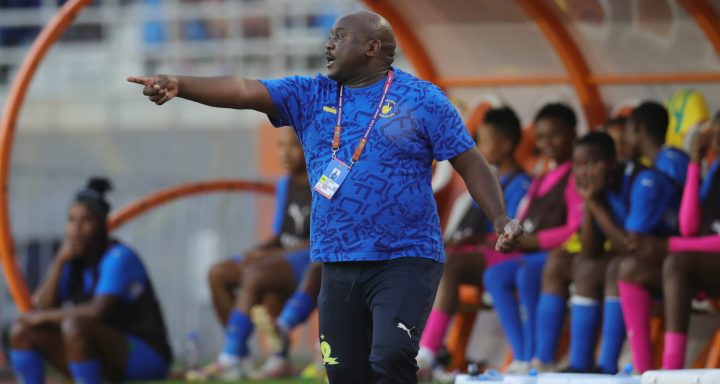It’s no secret that women’s sports, particularly from the perspective of team sports, is still trying to catch up to the structures and benefits enjoyed by the men in equivalent codes – from development pipelines, to opportunities for growth at those young and crucial ages, even via factors such as sponsorship and coverage, which ultimately play a pivotal part in the financial compensation of the athletes.
Global standards
In Europe, huge strides have been made over the past few decades. One example is the high-quality soccer regularly on display in the women’s English top-flight, the Super League.
And the US, which has long been the benchmark for quality women’s soccer, has generally continued on an upward trajectory, while countries such as Australia and Colombia have grown in stature, as shown by the displays at the 2023 Fifa World Cup.
Yet, in Africa, the chasm between men and women remains jarring. A number of women soccer players based in Africa – despite investing a significant amount of time and effort into their craft – usually have nothing to show for it financially.
In fact, sometimes these talented athletes incur financial loss just to be able to play their beloved sport.
Banyana Banyana coach Desiree Ellis has regularly lamented the fact that most of the players she has to choose from in the local Hollywoodbets Super League usually have full-time occupations to sustain themselves and their families as they pursue their passion of playing the sport.
Therefore some have struggled when called into the national team, despite shining at club level. Competitions such as the African Women’s Champions League are integral in helping to foster change.

Sibulele Holweni of the University of the Western Cape is challenged by Ladifatou Adjidja Ngambe of TP Mazembe during a CAF Women’s Champions League match at Ben M’Hamed El Abdi Stadium in El Jadida, Morocco, on 9 November 2024. (Photo: ©BackpagePix)
Battle of the best
First played in 2021, the Champions League marked a significant and deliberate step by the Patrice Motsepe-headed Confederation of African Football (Caf) to grow women’s soccer on the continent.
Before his ascension to Caf president, the club’s owner, Motsepe, had turned Sundowns into one of the most well-run women’s sports teams in Africa.
These days it is run by Motsepe’s son, Tlhopie. Under his leadership Sundowns have won two of the past three editions of Africa’s premier women’s club competition. In 2024, they are aiming to make it three out four editions by defending the crown they clinched a year ago.

Mamelodi Sundowns after winning the 2023 CAF Women’s Champions League final against Sporting Club Casablanca at Amadou Gon Coulibaly Stadium in Korhogo, Ivory Coast, on 19 November 2023. (Photo: ©Samuel Shivambu / BackpagePix)
It won’t be easy, as Sundowns found out after falling to debutants Masar in their opening game this year. The Egyptians dug deep to beat Banyana Ba Style 1-0.
“The level of competition has improved drastically in the last two editions. Teams have become more tactically aware, and there’s been a huge progress,” Sundowns coach Jerry Tshabalala told Caf’s media department.
“More clubs are investing in their women’s teams. We have seen teams like Simba Queens and TP Mazembe, which has raised the overall quality of play. The tournament is more competitive than ever, and this demands that we keep evolving,” Tshabalala added.
Sundowns, who are grouped with Nigeria’s Edo Queens and Ethiopian side CBE in addition to Masar, are one of two South African teams at the Morocco-hosted tournament.
Masandawana qualified automatically as defending champions, which left a gap for another southern African side to qualify. This honour went to fellow South Africans, the University of the Western Cape.

Jerry Tshabalala, coach of Mamelodi Sundowns Ladies, reacts during their CAF Women’s Champions League final against Sporting Club Casablanca in Korhogo, Ivory Coast, on 19 November 2023. (Photo: ©Samuel Shivambu / BackpagePix)
“It’s a huge milestone for women’s soccer in South Africa to have two clubs in the CAF Women’s Champions League this year. It shows that our domestic league is growing in strength and that we are producing talent capable of competing at the highest level in Africa,” Tshabalala said.
“This can only benefit the overall development of the women’s game in South Africa and inspire more investment and growth,” he added.
In another milestone, the prize money for the competition has grown substantially in 2024. The overall pool to be shared among the eight participating teams is $2,350,000 (about R43-million), an increase of 52% from 2023. Each club is guaranteed at least $150,000 (R2.7-million), while the winners walk away with $600,000 (R11-million).
The fact that the best African men’s club will pocket almost four times that shows the gulf between the two sports. Yet, Caf is clearly heading in the right direction and these strides will eventually trickle down to the local level of the involved clubs. DM
.